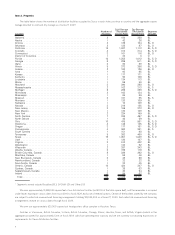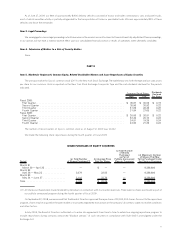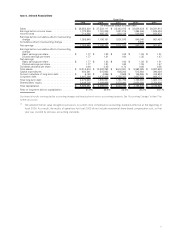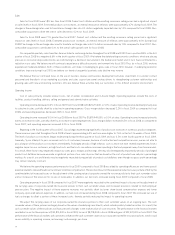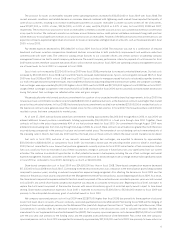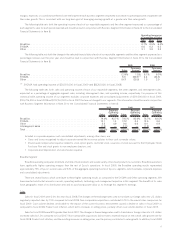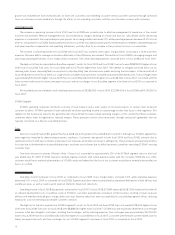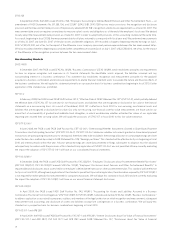Sysco 2009 Annual Report Download - page 38
Download and view the complete annual report
Please find page 38 of the 2009 Sysco annual report below. You can navigate through the pages in the report by either clicking on the pages listed below, or by using the keyword search tool below to find specific information within the annual report.
growth was realized both from increased sales to multi-unit customers and marketing associate-served customers primarily through continued
focus on customer account penetration through the efforts of our marketing associates and the use of business reviews with customers.
Operating Income
The increase in operating income in fiscal 2009 over fiscal 2008 was primarily due to effective management of operations in the current
economic environment. Effective management was also evidenced by margins declining at a lower rate than our sales decline and by decreasing
expenses as compared to the comparable prior year periods. Gross margin dollars decreased 1.7% while operating expenses decreased 3.2% in fiscal
2009 as compared to fiscal 2008. Expense performance for fiscal 2009 was aided by lower payroll-related expenses related to reduced headcount
and lower incentive compensation and operating efficiencies, partially offset by an increase in the provision for losses on receivables.
The increase in operating income in fiscal 2008 over fiscal 2007 was primarily due to gross margin dollars increasing at a faster pace than
expenses. We were able to manage our business effectively in the inflationary environment that existed in fiscal 2008 by managing margins and
improving operating efficiencies. Gross margin dollars increased 7.0% while operating expenses increased 6.0% in fiscal 2008 over fiscal 2007.
The high cost of fuel also impacted our Broadline segment’s results for fiscal 2009 and fiscal 2008. Fuel costs were $28,818,000 higher in fiscal
2009 over fiscal 2008. Fuel costs for fiscal 2008 were $21,575,000 higher than fiscal 2007. We attempt to mitigate increased fuel costs by
reducing miles driven, improving fleet consumption by adjusting idling time and maximum speeds and using fuel surcharges. In the second half of
fiscal 2008 and first half of fiscal 2009, our usage of fuel surcharges increased due to sustained increased market diesel prices. Fuel surcharges were
approximately $9,000,000 higher in fiscal 2009 than in fiscal 2008 and $21,000,000 higher in fiscal 2008 than in fiscal 2007. Consistent with the
lower current market price for diesel, we expect fuel costs and fuel surcharges for our Broadline segment to be lower in fiscal 2010 as compared to
fiscal 2009.
We recorded provisions related to multi-employer pension plans of $9,585,000 in fiscal 2009, $22,284,000 in fiscal 2008 and $4,700,000 in
fiscal 2007.
SYGMA Segment
SYGMA operating companies distribute a full line of food products and a wide variety of non-food products to certain chain restaurant
customer locations. SYGMA operations have traditionally had lower operating income as a percentage of sales than Sysco’s other segments. This
segment of the foodservice industry has generally been characterized by lower overall operating margins as the volume that these customers
command allows them to negotiate for reduced margins. These operations service chain restaurants through contractual agreements that are
typically structured on a fee per case delivered basis.
Sales
Sales for fiscal 2009 were 5.8% greater than fiscal 2008 and 4.4% greater in fiscal 2008 than fiscal 2007. Although our SYGMA segment has
been negatively impacted by deteriorating economic conditions, it achieved sales growth in both fiscal 2009 and fiscal 2008, primarily due to
significant contracts with new customers and product cost increases, which led to increases in selling prices. These increases were partially offset by
lost sales due to the elimination of unprofitable business and lower case volumes due to difficult economic conditions impacting SYGMA’s existing
customer base.
One chain restaurant customer (Wendy’s/Arby’s Group, Inc.) accounted for approximately 33% of the SYGMA segment sales for the fiscal
year ended June 27, 2009. SYGMA maintains multiple regional contracts with varied expiration dates with this customer. While the loss of this
customer would have a material adverse effect on SYGMA, we do not believe that the loss of this customer would have a material adverse effect on
Sysco as a whole.
Operating Income
Operating income increased in fiscal 2009 as compared to fiscal 2008. Gross margin dollars increased 0.4% while operating expenses
decreased 5.1% in fiscal 2009 as compared to fiscal 2008. Expense reductions were accomplished by operational efficiencies in both delivery and
warehouse areas, as well as lower payroll expense related to headcount reductions.
Operating income in fiscal 2008 decreased as compared to fiscal 2007. In fiscal 2008, SYGMA expensed $5,587,000 related to the write-off
of software development costs. In addition, some of SYGMA’s customers experienced a slowdown in their business resulting in lower cases per
delivery and therefore reduced gross margin dollars per stop. Expense reductions were accomplished by consolidating regional offices, reducing
headcounts and not renewing unprofitable customer contracts.
The high cost of fuel also impacted our SYGMA segment’s results for fiscal 2009 and fiscal 2008. Fuel costs were $2,028,000 higher in fiscal
2009 over fiscal 2008. Fuel costs for fiscal 2008 were $8,888,000 higher than fiscal 2007. SYGMA was able to partially offset these costs through
increases in the fees charged to customers, including fuel surcharges, and by reducing expenses. Fuel surcharges were approximately $5,000,000
lower in fiscal 2009 than in fiscal 2008 and $6,000,000 higher in fiscal 2008 than in fiscal 2007. Consistent with the lower current market price for
diesel, we expect fuel costs and fuel surcharges for our SYGMA segment to be lower in fiscal 2010 as compared to fiscal 2009.
18


